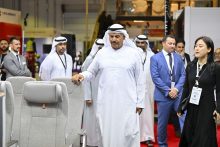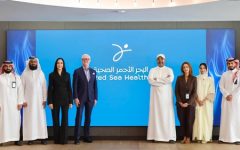 His Excellency Khalifa Al Zaffin, Executive Chairman of Dubai Aviation City Corporation and Dubai South, today opened MRO Middle East and Aircraft Interiors Middle East (AIME) 2024. Running until 6th March, the co-located events are welcoming leaders from across the global aviation supply chain at a time where the industry is on a strong upwards trajectory, particularly in the Middle East. According to Airbus’ latest Global Services Forecast, the region’s commercial aircraft services market will more than double in value by 2042, growing from $12 billion to $28 billion and registering a 4.4% average annual growth, surpassing the global average growth of 3.6%.
His Excellency Khalifa Al Zaffin, Executive Chairman of Dubai Aviation City Corporation and Dubai South, today opened MRO Middle East and Aircraft Interiors Middle East (AIME) 2024. Running until 6th March, the co-located events are welcoming leaders from across the global aviation supply chain at a time where the industry is on a strong upwards trajectory, particularly in the Middle East. According to Airbus’ latest Global Services Forecast, the region’s commercial aircraft services market will more than double in value by 2042, growing from $12 billion to $28 billion and registering a 4.4% average annual growth, surpassing the global average growth of 3.6%.
Set to contribute to this growth, the show has seen a 20% increase in footfall, and more than 240 exhibitors and 120 airlines have gathered to explore new avenues of collaboration, commercial opportunities and showcase industry-leading products and services. Key announcements and signings during the first day of MRO Middle East and AIME included Joramco announcing a new maintenance agreement with TUI, and HAECO announcing the induction of Emirates’ first Airbus A380 aircraft at its airframe facility in Xiamen, marking a new base maintenance contract between the two entities.
The Go Live! Theater welcomed a host of global experts for sessions on key industry themes. The ‘Capacity Issues on the Horizon?’ panel discussed fleet expansion plans, collaboration and what MROs, OEMs and other suppliers must do to ensure they have enough bandwidth to sustain the new fleet size in the region.
During the session, Justin ODonnell, Director Technical Operations at Riyadh Air, said: The transient nature of seasonal passenger traffic influences airlines to behave in ways that create a surge in MROs, especially during the winter period, where we aim to utilise 100% of the available capacity, and I acknowledge the challenges this presents for MROs… Competition, particularly in the Middle East, is on the rise, as observed recently. The Middle East MROs are gaining global appeal, making it more challenging for Middle Eastern airlines to secure the same capacity. Our long-term strategy involves planning well in advance, looking at the full cycle ahead.”
‘The Future of Cabin Design – Anticipating and Adapting to Emerging Trends’ panel discussed the key focuses for the industry, including sustainability, connectivity of aircraft and passenger comfort. During the session, a live audience poll found that ‘integration of technology and connectivity’ is the aspect of cabin design which is expected to see the most significant change in the next decade.
Speaking on this, Jo Rowan, Associate Director – Strategy at PriestmanGoode, highlighted one of the challenges: “We are thinking about the needs of Generation Alpha as the hyperconnected digital generation, alongside our aging population who may not even have smartphones and will have anxieties around things such as data sharing. This means it’s a challenging time where the spectrum is very broad.”
Meanwhile, Daniel Kerrison, Senior Vice President of Inflight Operations at flydubai, thinks that sustainability within aircraft will see the biggest change. “It’s a critical issue that will see really big change in the next ten years. There’s a shift coming in terms of the aircraft design process, the in-service life and post-service life, with sustainability being a key decision criteria.”
The co-located events will continue tomorrow at Dubai World Trade Centre, with further insightful content sessions and showcases of industry collaboration. For more information and last minute registration, please visit the websites mromiddleeast.aviationweek.com or www.aime.aero.
Breaking News
- Dusit International expands Saudi portfolio with new dusitD2 resort in Al Ahsa
- Emirates prohibits use of any kind of power bank onboard Emirates flights from 1st October 2025
- Red Sea Global unveils ‘Red Sea Health’ with first facility opening at new airport
- Department of Culture and Tourism – Abu Dhabi extends partnership to host multiple UAE Warriors events in Al Ain Region
- PIF and Golf Saudi launch PIF Future Fairways, showcasing the future of golf in Saudi Arabia
- Riyadh Air signs global distribution agreement with Amadeus in preparation for take-off
- Diriyah and THC explore new urban air mobility ventures
- VFS Global renews contract for Germany visa services across the Middle East; adds four new locations to the network
- Mileo The Palm, Hotel and Residences to open by this September
- RateHawk study reveals 92% of travel professionals are purpose driven
- Oman Air Holidays launches new digital platform with TUI
 Tourism Breaking News
Tourism Breaking News


